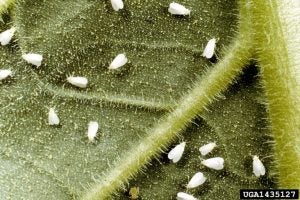2017 is the year of the whitefly
Published 4:55 pm Friday, August 11, 2017

An adult whitefly might looks like a small gnat, but they are more of a nuisance to your plants than your face.
Whitefly populations in commercial agriculture fields have been off the charts this year. It is believed that the extremely mild winter we experienced is largely to blame for the high populations this year. Whiteflies can be an economic pest in nearly all vegetable crops and some row crops including cotton and soybean. They also feed on a wide range of ornamental plants, so it is very likely that you will find them around your house.
Whitefly adults resemble small gnats. They range in size from 1/10 to 1/16th inch and have four broad, delicate, milk-white wings. The immature whiteflies are attached to the underside of leaves and resemble scale insects. They are oval, flattened and yellow to almost transparent. Whiteflies often occur in tremendous numbers and when a heavily infested plant is disturbed, the air is filled instantly with a white cloud of these insects.
The adults and juveniles largely feed on the bottom of plant leaves. This protects them from the sun, rainfall, and unfortunately sometimes insecticide sprays. Whiteflies cause damage to plants by directly feeding on the leaves, but also by the sugary excrement they drop on the top of the leaves below the leaf they are feeding on. At first the sugary excrement will make the leaves look glossy or shinny. Soon the excrement will begin to produce sooty mold which is a black substance that will cover the leaf and disrupt the plants ability to photosynthesize. Only in severe cases can whiteflies cause plant death but often times the visible damage is not acceptable.
Products containing: Acetamiprid, imidacloprid, or insecticidal soap are commonly used in the landscape and home garden for control. Always read and follow the label to make sure you are applying to correct crop at the desired rate.




